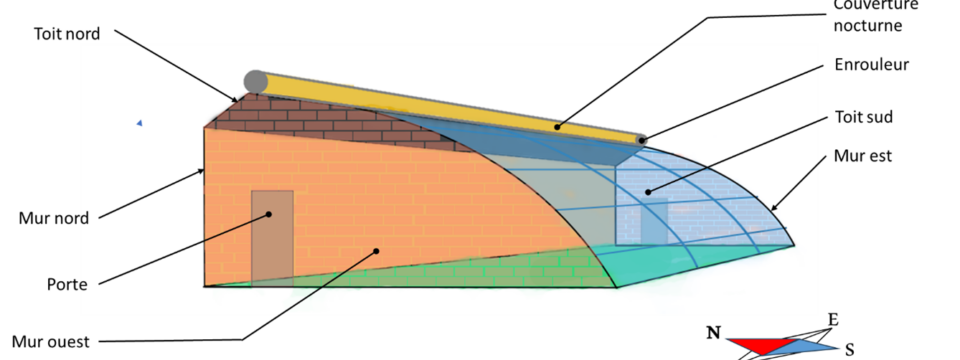Chinese Solar Greenhouse (CSG) describes a specific greenhouse geometry that is particularly adapted to cold climates.

Représentation schématique d’une Serre Chinoise. Marie Teillot. Octobre 2023
General Information
Technology: Chinese Solar Greenhouse
Cost: varies to materials used and of the labour cost. Classic models, however, are reputed to be inexpensive.
Level of difficulty to build it: moderate, it needs to be built.
Installation on an existing greenhouse: impossible
Sustainability: relatively good. The plastic film must be changed every year or two.
Automation: night covering can be automated
History:
Chinese Solar Greenhouses were developed during the 1980s in the Liaoning Province in China (Wu et al., 2023). The usage of such agricultural infrastructure was generalized in the north of China in the 1990s with the arrival of the plastic film (light and cheap). Moreover, the productivity requirement of the 8th five-year plan incited to developed CSG. (Tong et al., 2013).
Description:
A Chinese Solar Greenhouse has three opaque walls on the north, west and east sides and a transparent roof on the south. The north wall is used to stock the thermic energy. It captures thermal energy during the day, stores it and releases it at night. The north wall is typically built with one or multiple layers of brick, cob or cinder block. (Tong et al., 2013), (Cao et al., 2019)
The transparent roof on the south let the sun light enter the greenhouse. Thanks to this, the air is warmed. This south roof is typically built with plastic film supported by a light framework in wood, bamboo or metal. (Tong et al., 2013)
A thermal blanket is used in the night to improve the insulation of the greenhouse during the night. (Schiller & Plinke, 2016 ; Wu et al., 2023).
Efficiency
Although effective in cold climates, Chinese Greenhouse performances varies depending on the weather and solar irradiation conditions. The better the sun irradiation is, the better they perform. ; Decker, 2015). This efficiency cannot easily be summarized in one indicator. However, it is possible to give examples of existing greenhouse :
|
Place |
Latitude |
Year period |
Average Radiation |
Outside temperature |
Inside temperature |
|
Shengsay (North of China) |
48.8°N |
January |
4 kWh/m^2/Day |
Lower than -15°C |
Over 10° C |
|
Manitoba |
50°N |
Winter |
Between 2 and 4 kWh/m^2/Day |
Between -45 and -29°C |
Between -27 and -10°C |
Moreover, greenhouse design, particularly the calculation of south-roof inclination angles are quite important for the greenhouse efficiency. (Cao et al., 2019; Wu et al., 2023; Tong et al., 2013).
References
Cao, K., Xu, H., Zhang, R., Xu, D., Yan, L., Sun, Y., Xia, L., Zhao, J., Zou, Z., & Bao, E. (2019). Renewable and sustainable strategies for improving the thermal environment of Chinese solar greenhouses. Energy and Buildings, 202, 109414. https://doi.org/10.1016/j.enbuild.2019.109414
Decker, K. D. (2015, décembre 24). Réinventer la Serre. LOW←TECH MAGAZINE. https://solar.lowtechmagazine.com/fr/2015/12/reinventing-the-greenhouse/
Planification en République populaire de Chine. (2022). In Wikipédia. https://fr.wikipedia.org/w/index.php?title=Planification_en_r%C3%A9publique_populaire_de_Chine&oldid=189562037
Schiller, L., & Plinke, M. (2016). The year-round Solar Greenhouse (Vol. 1). New Society Publisher.
Tong, G., Christopher, D. M., Li, T., & Wang, T. (2013). Passive solar energy utilization : A review of cross-section building parameter selection for Chinese solar greenhouses. Renewable and Sustainable Energy Reviews, 26, 540‑548. https://doi.org/10.1016/j.rser.2013.06.026 Wu, X., Li, Y., Jiang, L., Wang, Y., Liu, X., & Li, T. (2023). A systematic analysis of multiple structural parameters of Chinese solar greenhouse based on the thermal performance. Energy, 273, 127193. https://doi.org/10.1016/j.energy.2023.127193
